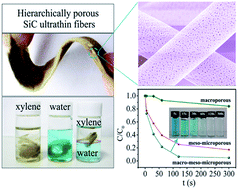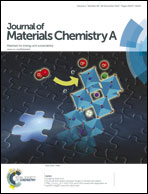Hierarchically porous SiC ultrathin fibers mat with enhanced mass transport, amphipathic property and high-temperature erosion resistance†
Abstract
Porous silicon carbide (SiC) has attracted considerable attention as an alternative catalyst support, particularly in corrosive and high-temperature environment. Herein, we report a facile strategy to controllably fabricate macroporous, meso-microporous and macro-meso-microporous SiC ultrathin fibers (M-SFs, MM-SFs and MMM-SFs, respectively) mats with good flexibility via electrospinning combined with polymer-derived ceramics route. The formation mechanism of different porous structures has been discussed. The MMM-SFs mat is found to exhibit simultaneously hydrophilic and lipophilic behaviors. Compared with M-SFs and MM-SFs, the MMM-SFs showed higher adsorption capacity, excellent adsorption durability and particularly faster adsorption rate (mass transport) in the adsorption experiments using methylene blue dye as a model. After being treated in dilute sulphuric acid for 5 h and subsequently heated at 800 °C for 1 h, the MMM-SFs retained their long-fiber shape and intact porous structure. Such a MMM-SFs mat may be of interest in high-temperature catalyst support, biosensor and biomedicine, energy storage, gas separation, particularly in harsh environment.


 Please wait while we load your content...
Please wait while we load your content...